Dinh-Thuy Phan-Huy
Neyman-Pearson Detector for Ambient Backscatter Zero-Energy-Devices Beacons
Apr 14, 2025Abstract:Recently, a novel ultra-low power indoor wireless positioning system has been proposed. In this system, Zero-Energy-Devices (ZED) beacons are deployed in Indoor environments, and located on a map with unique broadcast identifiers. They harvest ambient energy to power themselves and backscatter ambient waves from cellular networks to send their identifiers. This paper presents a novel detection method for ZEDs in ambient backscatter systems, with an emphasis on performance evaluation through experimental setups and simulations. We introduce a Neyman-Pearson detection framework, which leverages a predefined false alarm probability to determine the optimal detection threshold. This method, applied to the analysis of backscatter signals in a controlled testbed environment, incorporates the use of BC sequences to enhance signal detection accuracy. The experimental setup, conducted on the FIT/CorteXlab testbed, employs a two-node configuration for signal transmission and reception. Key performance metrics, which is the peak-to-lobe ratio, is evaluated, confirming the effectiveness of the proposed detection model. The results demonstrate a detection system that effectively handles varying noise levels and identifies ZEDs with high reliability. The simulation results show the robustness of the model, highlighting its capacity to achieve desired detection performance even with stringent false alarm thresholds. This work paves the way for robust ZED detection in real-world scenarios, contributing to the advancement of wireless communication technologies.
Ambient Backscatter Communication in LTE Uplink Sounding Reference Signal
Jan 19, 2025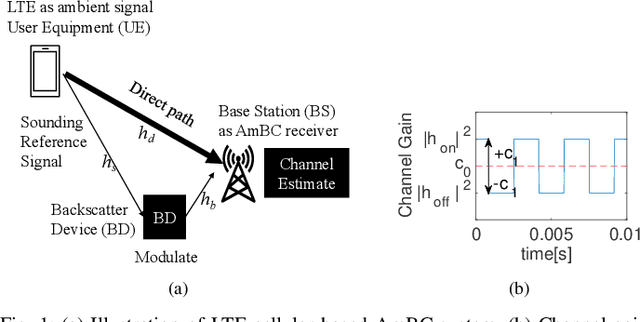
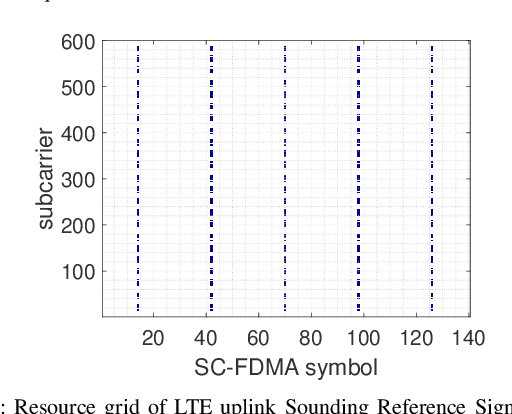
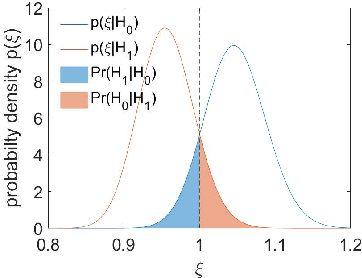
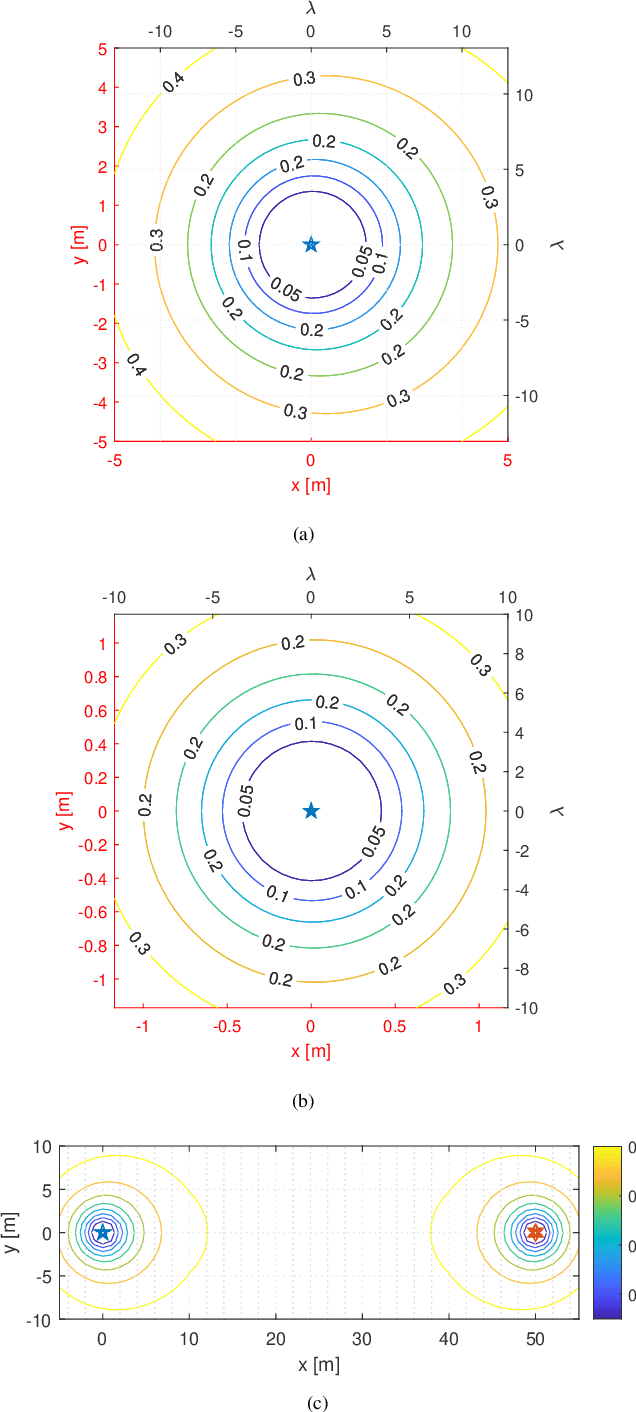
Abstract:Ambient Internet of Things (AIoT), recently standardized by the 3rd Generation Partnership Project (3GPP), demands a low-power wide-area communication solution that operates several orders of magnitude below the power requirements of existing 3GPP specifications. Ambient backscatter communication (AmBC) is considered as a competitive potential technique by harvesting energy from the ambient RF signal. This paper considers a symbiotic AmBC into Long Term Evolution (LTE) cellular system uplink. Leveraging by LTE uplink channel estimation ability, AIoT conveys its own message to Base Station (BS) by modulating backscatter path. We explore the detector design, analyze the error performance of the proposed scheme, provide exact expression and its Guassian approximation for the error probability. We corroborate the receiver error performance by Monte Carlo simulation. Analysis of communication range reveals AmBC achieves a reasonable BER of order of magnitude $10^{-2}$ within four times wavelength reading distance. In addition, a AmBC prototype in LTE uplink confirms the its feasibility. The over-the-air experiment results validate theoretical analysis. Hence, the proposed AmBC approach enables AIoT deployment with minimal changes to the LTE system.
Indoor Localization of Smartphones Thanks to Zero-Energy-Devices Beacons
Feb 26, 2024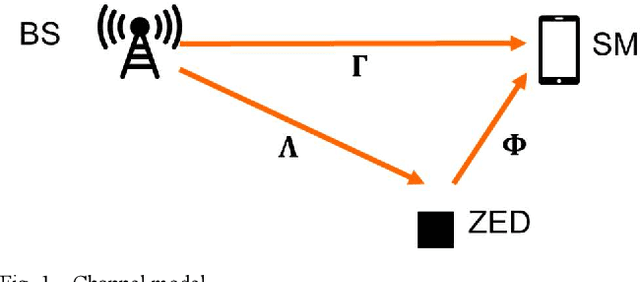
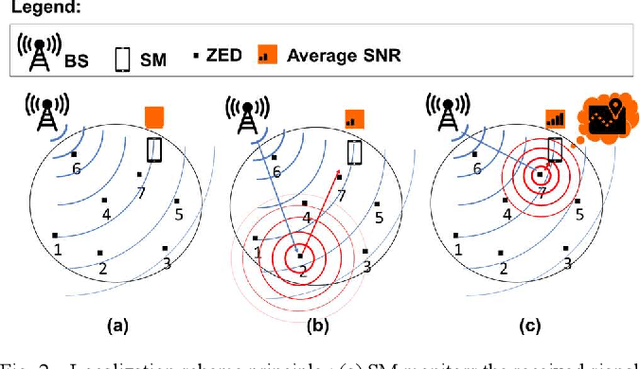
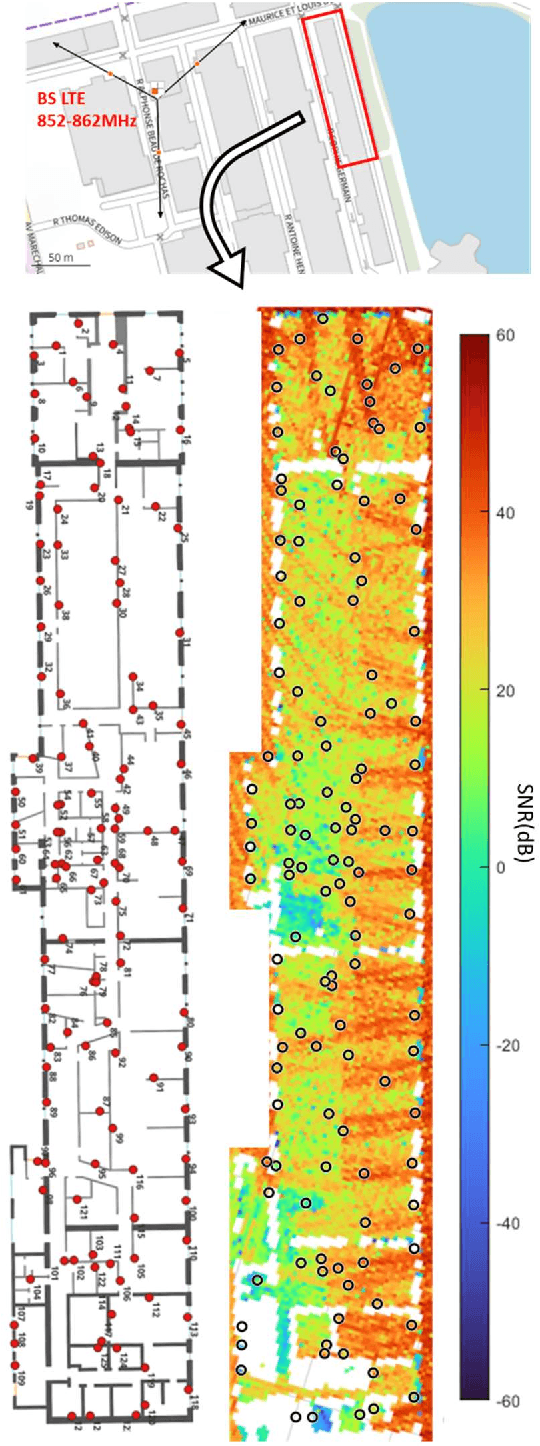
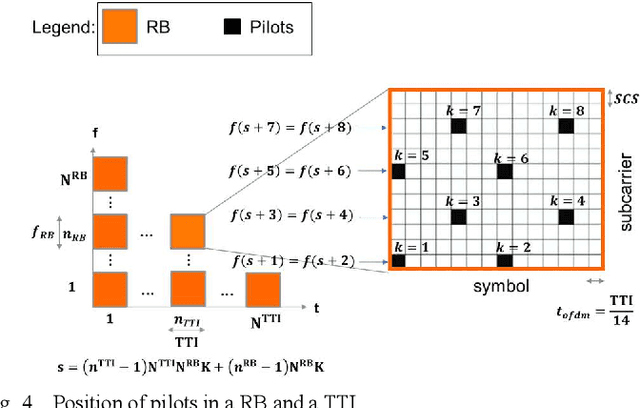
Abstract:In this paper, we present a new ultra-low power method of indoor localization of smartphones (SM) based on zero-energy-devices (ZEDs) beacons instead of active wireless beacons. Each ZED is equipped with a unique identification number coded into a bit-sequence, and its precise position on the map is recorded. An SM inside the building is assumed to have access to the map of ZEDs. The ZED backscatters ambient waves from base stations (BSs) of the cellular network. The SM detects the ZED message in the variations of the received ambient signal from the BS. We accurately simulate the ambient waves from a BS of Orange 4G commercial network, inside an existing large building covered with ZED beacons, thanks to a ray-tracing-based propagation simulation tool. Our first performance evaluation study shows that the proposed localization system enables us to determine in which room a SM is located, in a realistic and challenging propagation scenario.
Zero-energy Devices for 6G: Technical Enablers at a Glance
Feb 14, 2024Abstract:Low-cost, resource-constrained, maintenance-free, and energy-harvesting (EH) Internet of Things (IoT) devices, referred to as zero-energy devices (ZEDs), are rapidly attracting attention from industry and academia due to their myriad of applications. To date, such devices remain primarily unsupported by modern IoT connectivity solutions due to their intrinsic fabrication, hardware, deployment, and operation limitations, while lacking clarity on their key technical enablers and prospects. Herein, we address this by discussing the main characteristics and enabling technologies of ZEDs within the next generation of mobile networks, specifically focusing on unconventional EH sources, multi-source EH, power management, energy storage solutions, manufacturing material and practices, backscattering, and low-complexity receivers. Moreover, we highlight the need for lightweight and energy-aware computing, communication, and scheduling protocols, while discussing potential approaches related to TinyML, duty cycling, and infrastructure enablers like radio frequency wireless power transfer and wake-up protocols. Challenging aspects and open research directions are identified and discussed in all the cases. Finally, we showcase an experimental ZED proof-of-concept related to ambient cellular backscattering.
Experimental Demonstration of 3D Reflected Beamforming at sub6GHz thanks to Varactor Based Reconfigurable Intelligent Surface
Jul 13, 2023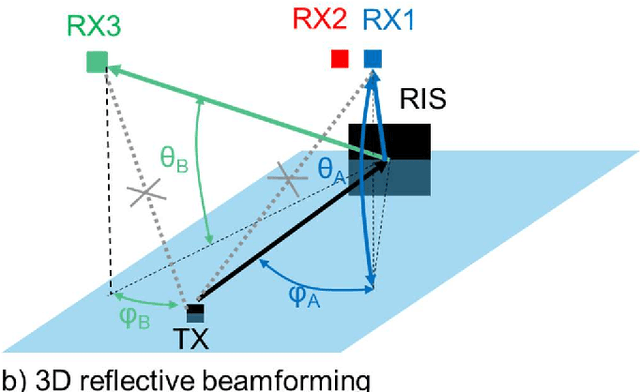
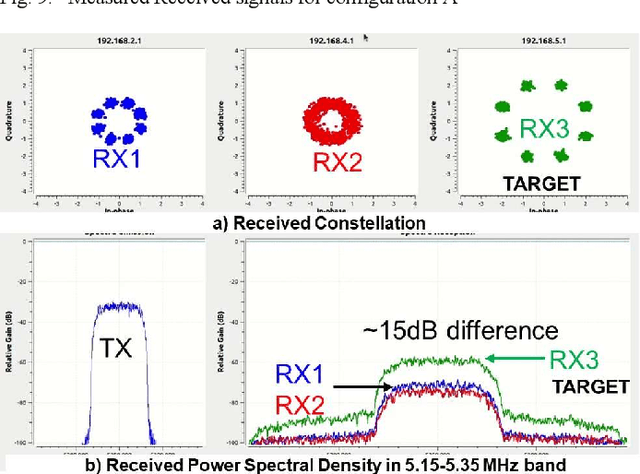
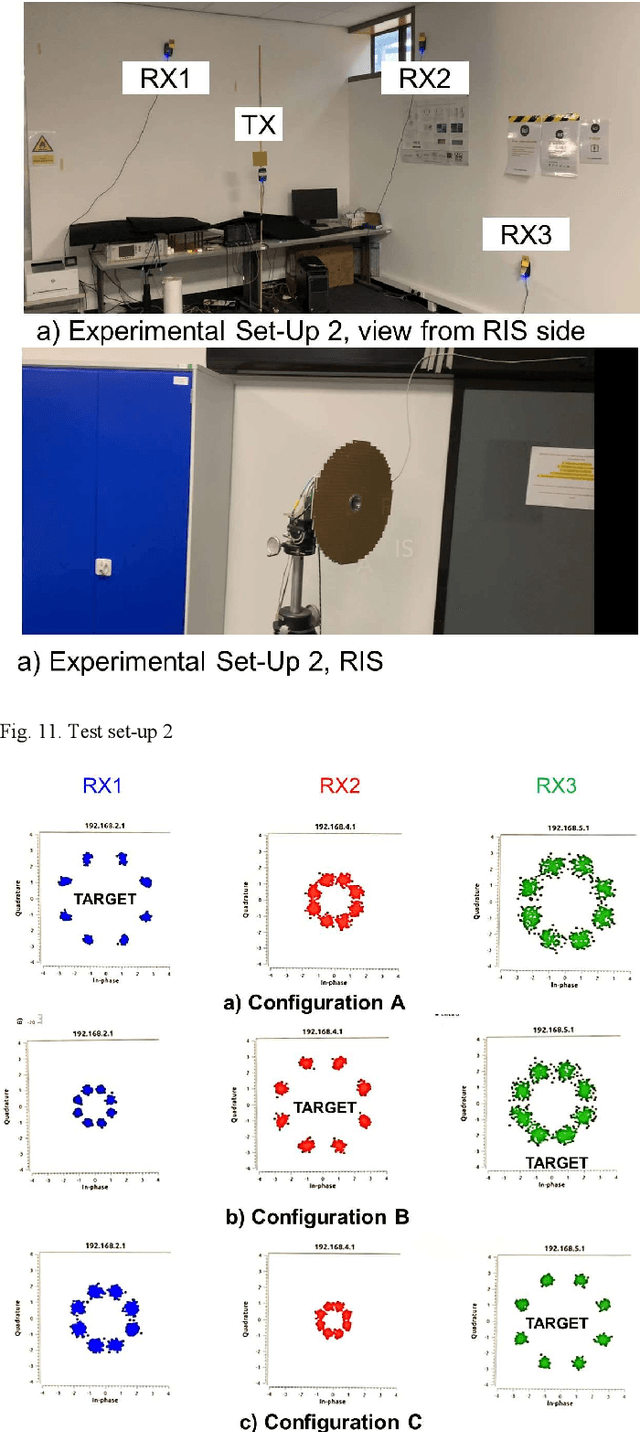
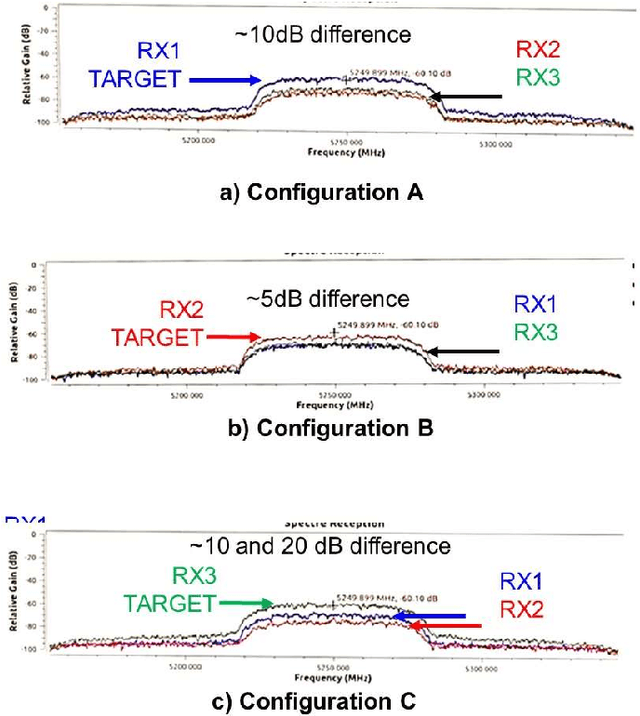
Abstract:Reconfigurable intelligent surface (RIS) is a promising solution to boost coverage sustainably by reflecting waves from a transmitter to a receiver and acting as a low-power and passive relay. In this paper, for the first time, we demonstrate experimentally that a reconfigurable intelligent surface designed for sub6GHz, and using varactor technology, can perform three-dimensional reflective beamforming. This result is achieved with a RIS prototype of 984 unit-cells, thanks to a compact control circuit individually addressing and configuring the voltage of each unit-cell, with a distinct voltage. To our knowledge, this prototype configures 17 to 70 times more distinct voltages than in the state-of-the-art. The experimental results in an indoor environment show a 10 dB gain. They also show, for the first time, that producing such a new prototype is feasible with minimal energy footprint and environmental impact, thanks to refurbishing. Indeed, a reflectarray antenna originally designed for three-dimensional beamforming has been turned into a RIS.
Electromagnetic Field Exposure Avoidance thanks to Non-Intended User Equipment and RIS
Oct 07, 2022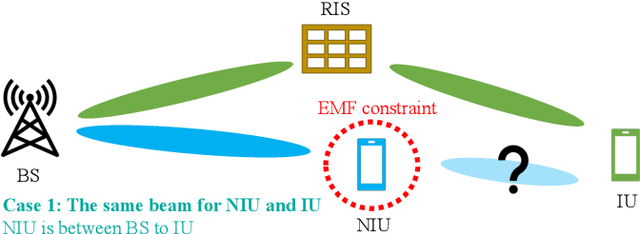
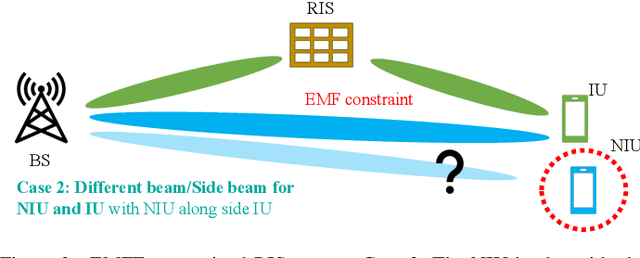
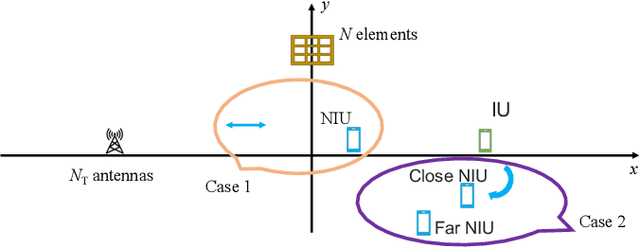
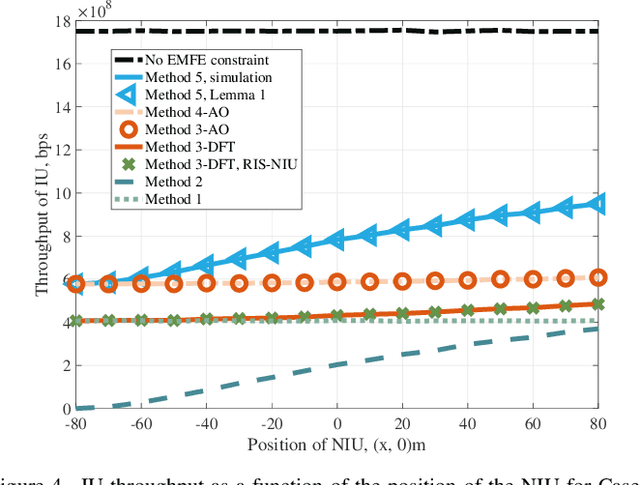
Abstract:On the one hand, there is a growing demand for high throughput which can be satisfied thanks to the deployment of new networks using massive multiple-input multiple-output (MIMO) and beamforming. On the other hand, in some countries or cities, there is a demand for arbitrarily low electromagnetic field exposure (EMFE) of people not concerned by the ongoing communication, which slows down the deployment of new networks. Recently, it has been proposed to take the opportunity, when designing the future 6th generation (6G), to offer, in addition to higher throughput, a new type of service: arbitrarily low EMFE. Recent works have shown that a reconfigurable intelligent surface (RIS), jointly optimized with the base station (BS) beamforming can improve the received throughput at the desired location whilst reducing EMFE everywhere. In this paper, we introduce a new concept of a non-intended user (NIU). An NIU is a user of the network who requests low EMFE when he/she is not downloading/uploading data. An NIU lets his/her device, called NIU equipment (NIUE), exchange some control signaling and pilots with the network, to help the network avoid exposing NIU to waves that are transporting data for another user of the network: the intended user (IU), whose device is called IU equipment (IUE). Specifically, we propose several new schemes to maximize the IU throughput under an EMFE constraint at the NIU (in practice, an interference constraint at the NIUE). Several propagation scenarios are investigated. Analytical and numerical results show that proper power allocation and beam optimization can remarkably boost the EMFE-constrained system's performance with limited complexity and channel information.
Dual Gradient Descent EMF-Aware MU-MIMO Beamforming in RIS-Aided 6G Networks
Oct 03, 2022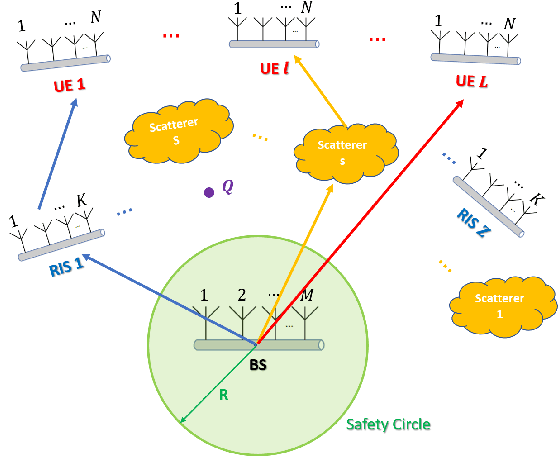
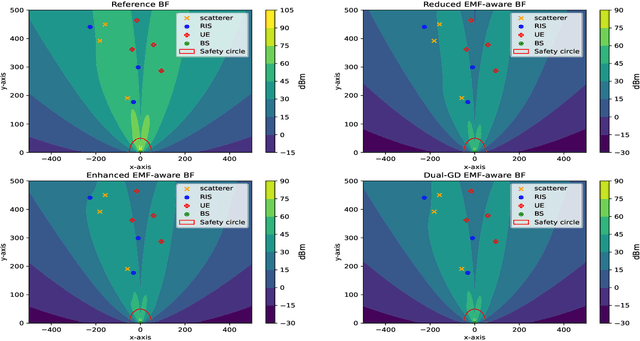
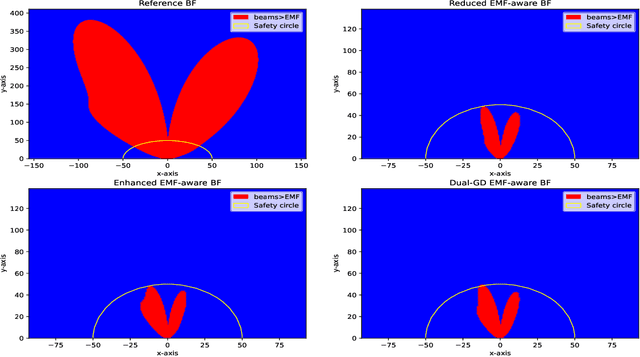
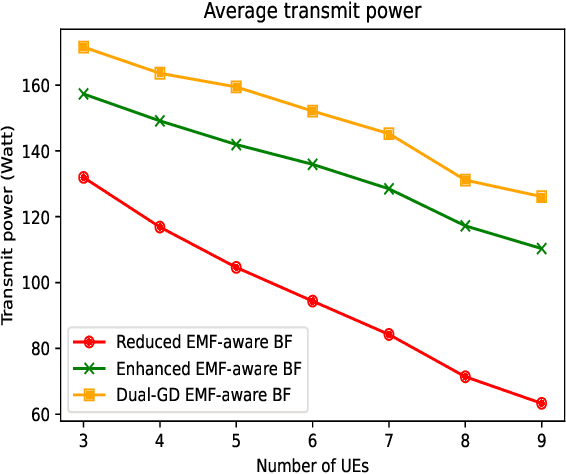
Abstract:Reconfigurable Intelligent Surface (RIS) is one of the key technologies for the upcoming 6th Generation (6G) communications, which can improve the signal strength at the receivers by adding artificial propagation paths. In the context of Downlink (DL) Multi-User Multiple-Input Multiple-Output (MU-MIMO) communications, designing an appropriate Beamforming (BF) scheme to take full advantage of this reconfigured propagation environment and improve the network capacity is a major challenge. Due to the spatial dimension provided by MIMO systems, independent data streams can be transmitted to multiple users simultaneously on the same radio resources. It is important to note that serving the same subset of users over a period of time may lead to undesired areas where the average Electromagnetic Field Exposure (EMFE) exceeds regulatory limits. To address this challenge, in this paper, we propose a Dual Gradient Descent (Dual-GD)-based Electromagnetic Field (EMF)-aware MU-MIMO BF scheme that aims to optimize the overall capacity under EMFE constraints in RIS-aided 6G cellular networks.
EMF-Aware MU-MIMO Beamforming in RIS-Aided Cellular Networks
Sep 29, 2022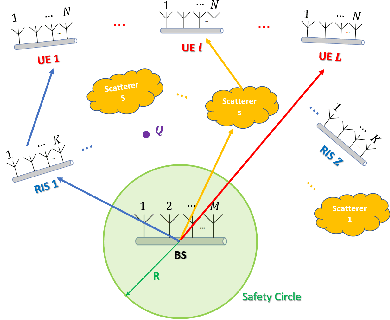
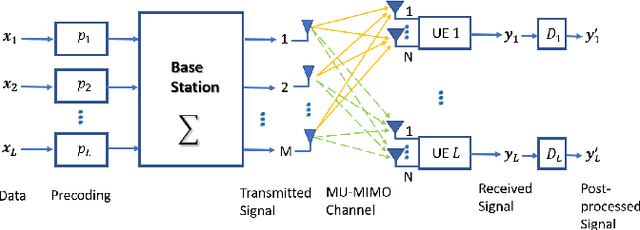
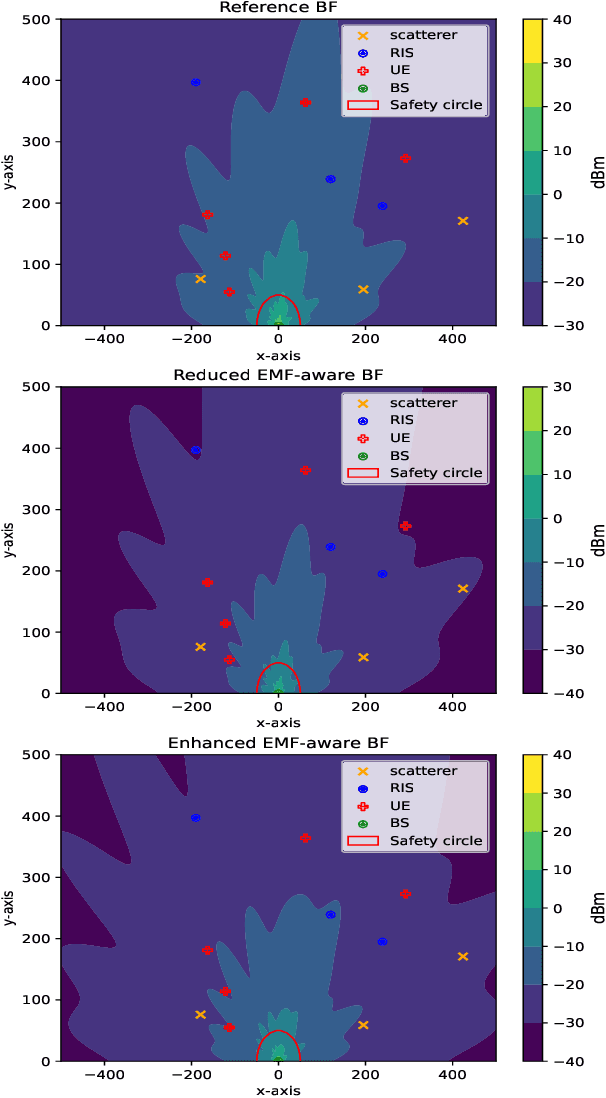
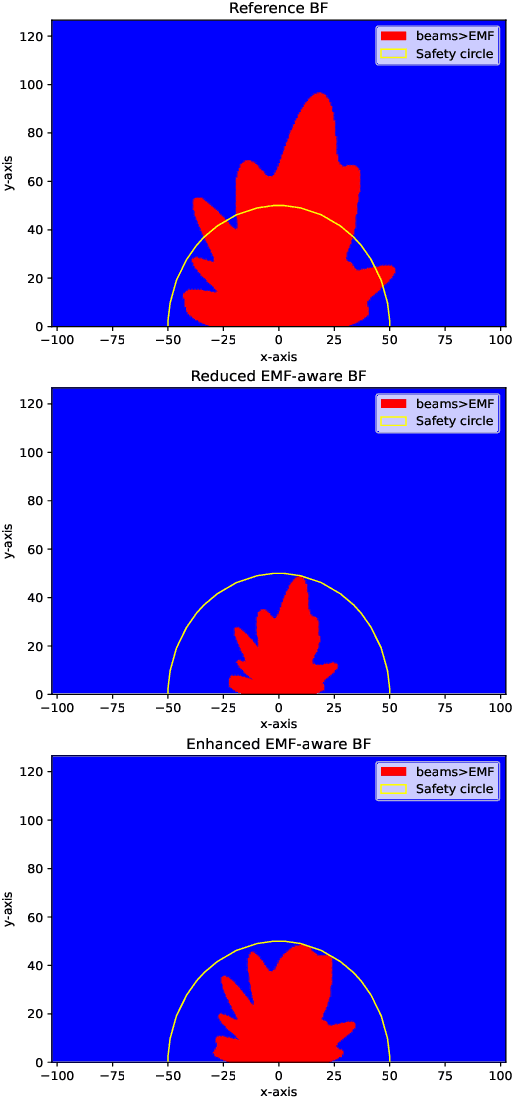
Abstract:Reconfigurable Intelligent Surfaces (RISs) are one of the key emerging 6th Generation (6G) technologies that are expected to improve the link budgets between transmitters and receivers by adding artificial propagation paths. In such re-configured propagation environment, Downlink (DL) Multi-User Multi-Input Multi-Output (MU-MIMO) brings capacity improvement to cellular networks. It benefits from the spatial dimension offered by MIMO systems to enable simultaneous transmission of independent data streams to multiple users on the same radio resources by applying appropriate Beamforming (BF) schemes. However, in some cases, serving the same subset of users for a long period of time may cause some undesired regions where the average Electromagnetic Field Exposure (EMFE) exceeds the regulatory limits. To address this challenge, we propose in this paper a novel Electromagnetic Field (EMF) aware MU-MIMO BF scheme that aims to optimize the overall capacity under EMF constraints in RIS-aided cellular networks.
Creating and Operating Areas With Reduced Electromagnetic Field Exposure Thanks to Reconfigurable Intelligent Surfaces
Jun 14, 2022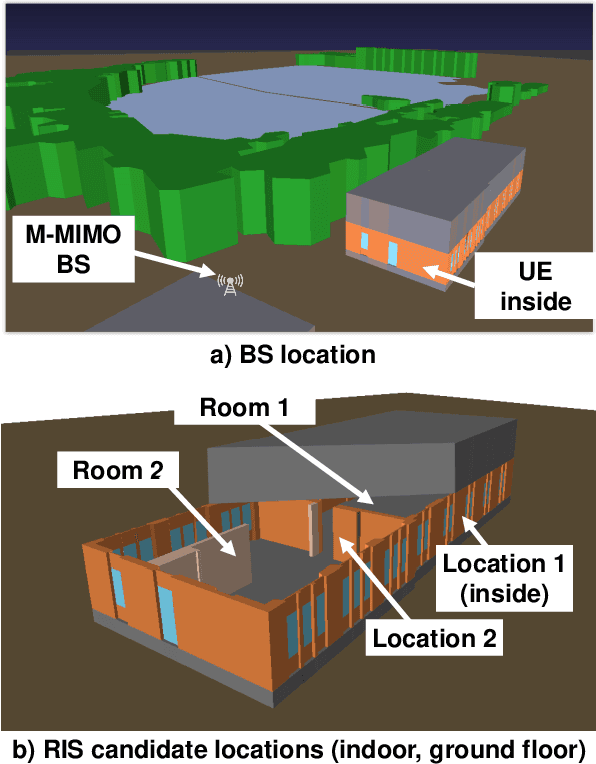
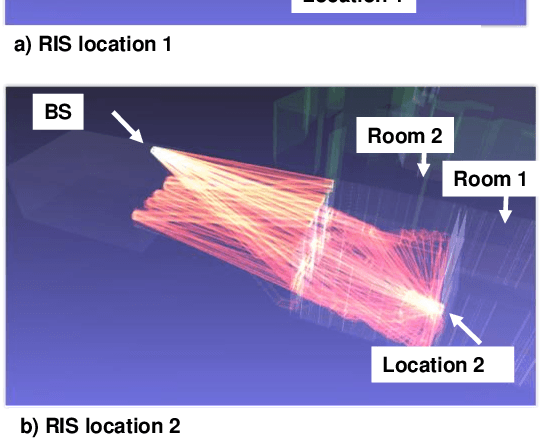
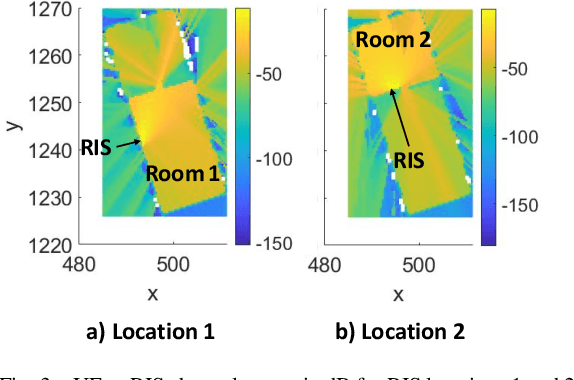
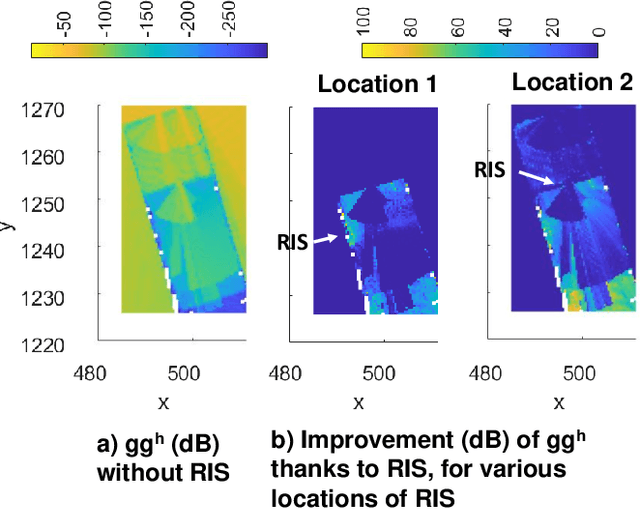
Abstract:Mobile network operators must provide a target quality of service within a target coverage area. Each generation of networks from the 2nd to the 5th has reached higher quality-of-service (QoS) targets and coverage area sizes. However, the deployment of new networks is sometimes challenged by Electromagnetic Field (EMF) exposure constraints. In this paper, to take into account these constraints, we assess the novel and recent concept of Reduced EMF Exposure Area. Such an area would be created and operated by a mobile network operator upon the request of its customers. In such an area, customers keep enjoying high data rate internet access while getting a reduced EMF exposure. To ensure this EMF exposure reduction, we propose to deploy Reconfigurable Intelligent Surfaces (RIS) connected to the mobile network and exploit a joint RIS-M-MIMO uplink beamforming scheme. We use our ray-tracing-based simulation tool to visualize and characterize the Reduced EMF Exposure Area in a challenging environment in terms of propagation. Our simulations show that an operator can create and operate such an area under the condition that it carefully places the RIS in the environment.
A Novel RIS-Aided EMF-Aware Beamforming Using Directional Spreading, Truncation and Boosting
Jun 14, 2022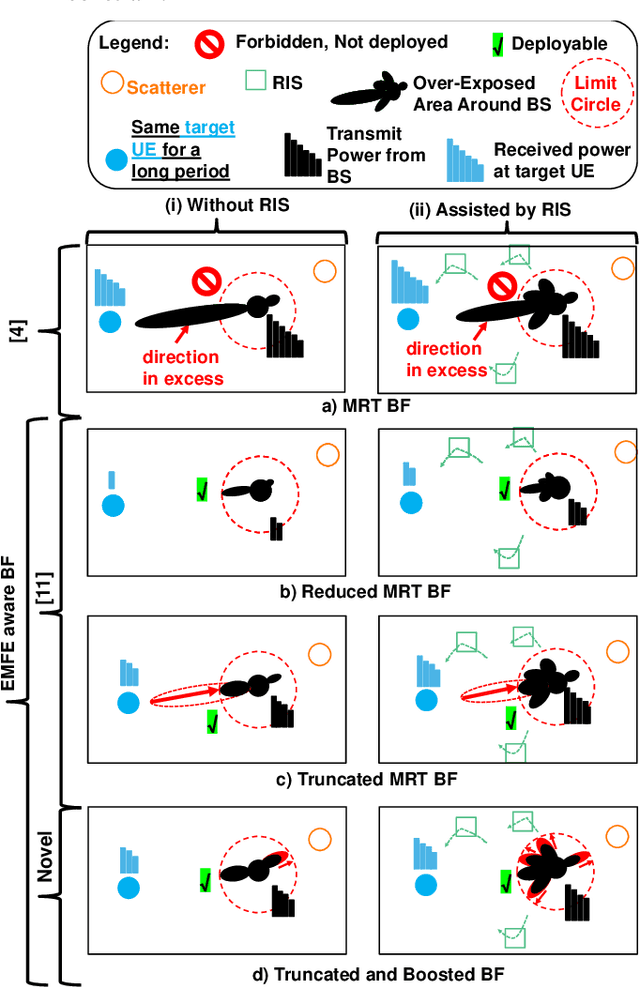
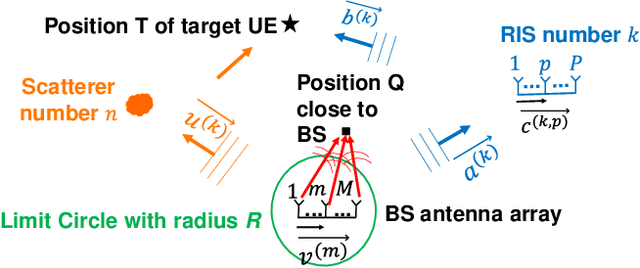
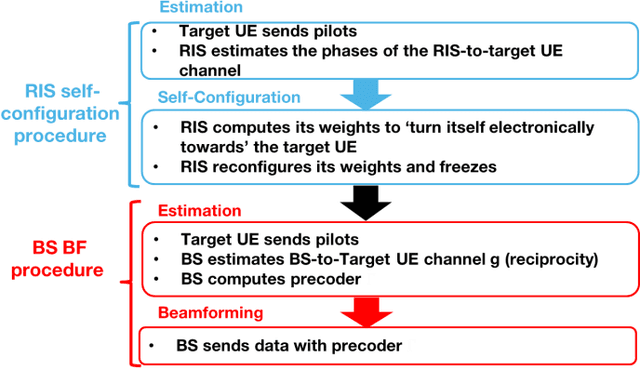
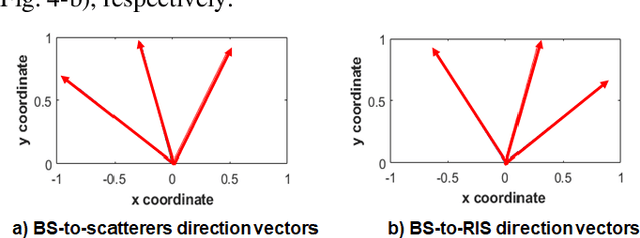
Abstract:This paper addresses a drawback of massive multiple-input multiple-output Maximum Ratio Transmission beamforming. In some propagation conditions, when the base station serves the same target user equipment for a long period, it reduces the transmit power (and degrades the received power) to avoid creating high exposure regions located in the vicinity of the antenna and concentrated in few directions (corresponding to the best propagation paths between the antenna and the receiver). In this paper, we propose a novel electromagnetic field aware beamforming scheme, which (i) spreads the beamforming radiation pattern in the angular domain by adding artificial propagation paths thanks to reconfigurable intelligent surfaces, (ii) truncates the pattern in strong directions, and (iii) boosts it in weak directions. Compared to existing solutions, it maximizes the received power. However, it also consumes more power. Finally, truncation alone is the best trade-off between received power and energy efficiency, under exposure constrain.
 Add to Chrome
Add to Chrome Add to Firefox
Add to Firefox Add to Edge
Add to Edge